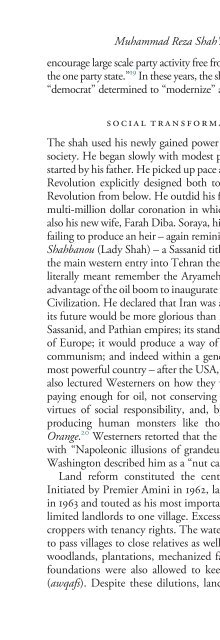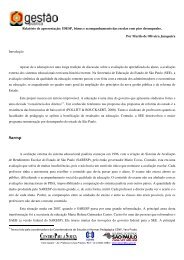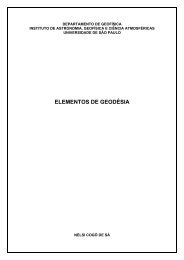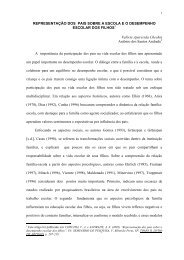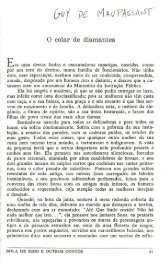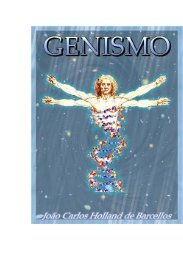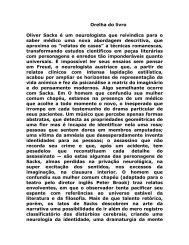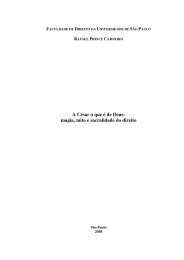A HISTORY OF MODERN IRAN - Stoa
A HISTORY OF MODERN IRAN - Stoa
A HISTORY OF MODERN IRAN - Stoa
You also want an ePaper? Increase the reach of your titles
YUMPU automatically turns print PDFs into web optimized ePapers that Google loves.
Muhammad Reza Shah’s White Revolution 131<br />
encourage large scale party activity free from the strait-jacket of one party rule or<br />
the one party state.” 19 In these years, the shah still liked to bill himself as a sincere<br />
“democrat” determined to “modernize” ahighly“traditional society.”<br />
social transformations (1953–77)<br />
The shah used his newly gained power to bring about changes in the larger<br />
society. He began slowly with modest programs designed to complete those<br />
started by his father. He picked up pace after 1963, when he launched a White<br />
Revolution explicitly designed both to compete with and preempt a Red<br />
Revolution from below. He outdid his father by staging with much fanfare a<br />
multi-million dollar coronation in which he crowned not only himself but<br />
also his new wife, Farah Diba. Soraya, his second wife, had been discarded for<br />
failing to produce an heir – again reminiscent of Napoleon. Farah was named<br />
Shahbanou (Lady Shah) – a Sassanid title. To mark the occasion, he built on<br />
the main western entry into Tehran the gigantic Shahyad Monument which<br />
literally meant remember the Aryamehr Shah. What is more, he took full<br />
advantage of the oil boom to inaugurate with even more fanfare his new Great<br />
Civilization. He declared that Iran was at the gates of the Great Civilization;<br />
its future would be more glorious than its past – including the Achaemenid,<br />
Sassanid, and Pathian empires; its standard of living would soon surpass that<br />
of Europe; it would produce a way of life superior to both capitalism and<br />
communism; and indeed within a generation it would be the world’s fifth<br />
most powerful country – after the USA, Soviet Union, Japan, and China. He<br />
also lectured Westerners on how they were not working hard enough, not<br />
paying enough for oil, not conserving valuable resources, not teaching the<br />
virtues of social responsibility, and, by not disciplining their youngsters,<br />
producing human monsters like those in the popular film Clockwork<br />
Orange. 20 Westerners retorted that the shah had become a “megalomaniac”<br />
with “Napoleonic illusions of grandeur.” One secretary of the treasury in<br />
Washington described him as a “nut case”.<br />
Land reform constituted the centerpiece of the White Revolution.<br />
Initiated by Premier Amini in 1962, land reform was adopted by the shah<br />
in 1963 and touted as his most important achievement. Amini’s initial plan<br />
limited landlords to one village. Excess land was to be transferred to sharecroppers<br />
with tenancy rights. The watered-down version allowed landlords<br />
to pass villages to close relatives as well as to keep for themselves orchards,<br />
woodlands, plantations, mechanized farms, and agrobusinesses. Religious<br />
foundations were also allowed to keep their long-standing endowments<br />
(awqafs). Despite these dilutions, land reform accomplished what it was


